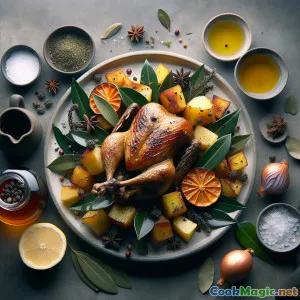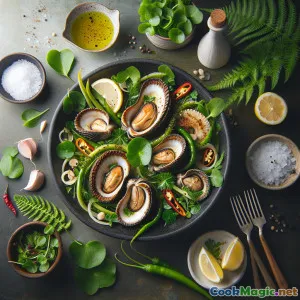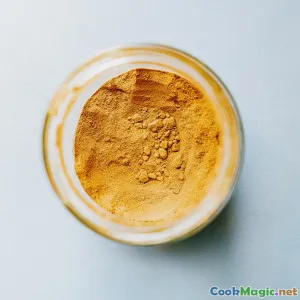
配 Kawakawa 黄油的 Tītī 烤制
(Roasted Tītī with Kawakawa Butter)
(0 评论)食材
-
2 birds 盐渍 tītī(muttonbird),整只
(Traditionally preserved; ensure legally and ethically sourced)
-
2 liters 浸泡用冷水
(May need more to refresh; change water 2–3 times)
-
10 leaves 卡瓦卡瓦叶,鲜
(Choose young leaves; avoid heavily spotted insect damage)
-
80 grams 无盐黄油,室温软化
(Room temperature for easy mixing)
-
2 cloves 细蒜泥
(Mellow in hot fat; do not burn)
-
1 tsp 柠檬皮屑(细)
(Adds freshness to balance richness)
-
1 tbsp 麦卢卡蜂蜜
(Optional touch of sweetness; any floral honey works)
-
600 grams Kumara(红薯),去皮并切成块
(Orange or red varieties roast well)
-
1 medium 洋葱,厚切片
(Acts as a trivet and sweetens the pan juices)
-
2 leaves 月桂叶
(Layers aromatic depth with kawakawa)
-
4 Berries 杜松子,轻轻捣碎
(Echoes wild, gamey notes)
-
2 tbsp 橄榄油
(For roasting kumara and onions)
-
1 tbsp 苹果醋
(Brightens pan juices at the end)
-
0.5 tsp 现磨黑胡椒
(Season to taste; salt is often unnecessary)
-
0.25 tsp 海盐
(Use sparingly; tītī is naturally salty)
-
1 cup 西洋菜或 puha (sow thistle),供上桌用
(Peppery greens cut richness)
-
4 wedges 柠檬角
(用于餐桌挤压)
(Traditionally preserved; ensure legally and ethically sourced)
(May need more to refresh; change water 2–3 times)
(Choose young leaves; avoid heavily spotted insect damage)
(Room temperature for easy mixing)
(Mellow in hot fat; do not burn)
(Adds freshness to balance richness)
(Optional touch of sweetness; any floral honey works)
(Orange or red varieties roast well)
(Acts as a trivet and sweetens the pan juices)
(Layers aromatic depth with kawakawa)
(Echoes wild, gamey notes)
(For roasting kumara and onions)
(Brightens pan juices at the end)
(Season to taste; salt is often unnecessary)
(Use sparingly; tītī is naturally salty)
(Peppery greens cut richness)
(用于餐桌挤压)
营养
- 份量: 4
- 每份大小: 1 portion (approx. 300g)
- Calories: 620 kcal
- Carbohydrates: 0 g
- Protein: 28 g
- Fat: 32 g
- Fiber: 7 g
- Sugar: 11 g
- Sodium: 980 mg
- Cholesterol: 165 mg
- Calcium: 110 mg
- Iron: 3.6 mg
制作步骤
-
1 - Desalt and refresh the tītī:
Rinse the salted tītī under cold water, then submerge in fresh cold water. Refrigerate 8–12 hours, changing the water 2–3 times to temper salinity.
-
2 - Render and parboil:
Place refreshed tītī in a pot with fresh water to cover, add bay and juniper if using. Simmer gently 30–40 minutes to render excess fat and further mellow the cure. Drain well and pat dry.
-
3 - Make kawakawa butter:
Finely mince 6 kawakawa leaves. Mix with softened butter, garlic, lemon zest, and mānuka honey (if using) until uniform. Reserve 1–2 whole leaves for later.
-
4 - Prepare the roasting base:
Heat oven to 200°C (392°F). Toss kumara and onion with olive oil and black pepper on a roasting tray. Spread into an even layer to form a trivet for the birds.
-
5 - Butter and truss the birds:
Gently loosen skin over the breast. Rub half the kawakawa butter under skin and over the birds. Tuck reserved whole kawakawa leaves inside cavity. Lightly truss legs for even roasting.
-
6 - Roast until bronzed:
Place tītī atop the kumara-onion base. Roast 25 minutes at 200°C, then reduce to 180°C (356°F) and continue 10–15 minutes until skin is deep golden and kumara tender.
-
7 - Baste and brighten:
Melt remaining kawakawa butter and baste birds. Splash apple cider vinegar into the tray and baste again to emulsify drippings, creating a glossy, aromatic pan sauce.
-
8 - Rest, Carve, and Serve:
Rest 10 minutes. Carve across the grain, serving with kumara, pan juices, peppery greens, and lemon wedges. Taste before adding any extra salt.
Rinse the salted tītī under cold water, then submerge in fresh cold water. Refrigerate 8–12 hours, changing the water 2–3 times to temper salinity.
Place refreshed tītī in a pot with fresh water to cover, add bay and juniper if using. Simmer gently 30–40 minutes to render excess fat and further mellow the cure. Drain well and pat dry.
Finely mince 6 kawakawa leaves. Mix with softened butter, garlic, lemon zest, and mānuka honey (if using) until uniform. Reserve 1–2 whole leaves for later.
Heat oven to 200°C (392°F). Toss kumara and onion with olive oil and black pepper on a roasting tray. Spread into an even layer to form a trivet for the birds.
Gently loosen skin over the breast. Rub half the kawakawa butter under skin and over the birds. Tuck reserved whole kawakawa leaves inside cavity. Lightly truss legs for even roasting.
Place tītī atop the kumara-onion base. Roast 25 minutes at 200°C, then reduce to 180°C (356°F) and continue 10–15 minutes until skin is deep golden and kumara tender.
Melt remaining kawakawa butter and baste birds. Splash apple cider vinegar into the tray and baste again to emulsify drippings, creating a glossy, aromatic pan sauce.
Rest 10 minutes. Carve across the grain, serving with kumara, pan juices, peppery greens, and lemon wedges. Taste before adding any extra salt.
关于 配 Kawakawa 黄油的 Tītī 烤制 :的更多信息
Overview
Tītī, the traditional name for muttonbird (sooty shearwater), is a treasured kai (food) for many Māori communities, especially Kāi Tahu/Ngāi Tahu whānau of Rakiura (Stewart Island) who have customary rights to harvest and preserve these seabirds. This recipe honors that heritage by pairing roasted tītī with kawakawa, a native peppery leaf (Piper excelsum) that lends warm, citrusy, and gently anesthetic notes. Because tītī is typically preserved in brine or rendered fat, it carries intense savoriness that benefits from careful desalting, gentle rendering, and aromatic balance. The result is a deeply flavorful roast with crisp skin, succulent meat, and a pan sauce that sings with native herbs.
Why this works
- Rendering and parboiling: Traditional tītī is rich and salty. A short simmer after soaking renders excess fat and mellows salinity without losing the bird’s signature character.
- Kawakawa butter: Fat is flavor’s best friend. Infusing softened butter with shredded kawakawa, lemon zest, garlic, and a whisper of mānuka honey creates a compound that penetrates the meat and perfumes the pan juices. Kawakawa’s peppery lift and gentle bitterness balance the bird’s richness beautifully.
- Kumara trivet: Roasting the birds over kumara and onions does more than create a side dish—it also aerates the underside of the birds for even roasting while catching drippings, which glaze the vegetables and become the base for a glossy sauce.
Tips & notes
- Sourcing: Only use legally and ethically sourced tītī. If tītī is not available where you live, duck or small game birds like squab can approximate the texture and fat level, though the flavor will differ.
- Balancing salinity: Tītī varies from mildly to intensely salty. Taste the parboiling water after 20 minutes—if it is very salty, refresh with new hot water and continue simmering. You can also reduce or omit added salt in the recipe.
- Handling kawakawa: Select young, healthy leaves. Finely shred for the butter to avoid fibrous bites. If kawakawa isn’t available, substitute with a mix of mild pepper leaves, sorrel, or a 50/50 blend of parsley and a pinch of ground black pepper—understanding the flavor won’t be identical.
- Texture and doneness: The birds should be well bronzed with crisp skin, and the leg joints should move freely. Overcooking can dry the breast; resting allows juices to settle.
- Smoke option: For a whisper of traditional smokiness, briefly smoke the parboiled birds with mānuka chips before roasting, or add a teaspoon of liquid smoke to the butter if you lack a smoker.
- Pan sauce polish: The splash of cider vinegar at the end brightens the drippings and helps emulsify remaining butter. A squeeze of lemon at the table lets each diner fine-tune acidity.
Cultural significance
For generations, the tītī harvest has been integral to seasonal cycles, whānau connections, and food sovereignty for southern Māori. Preservation ensured nutrient-dense food through winter, and the flavor became a marker of home and celebration. Sharing tītī today is both sustenance and story—an embodiment of whakapapa, place, and skill. Using kawakawa further anchors the dish within Aotearoa’s landscapes and mātauranga Māori (knowledge systems), drawing on the leaf’s long-standing role as a culinary and rongoā (traditional medicinal) plant. Respect for these ingredients means respecting tikanga (customs), including correct sourcing and gratitude for the mauri (life force) of what we eat.
Serving ideas
- Pair with wilted watercress or puha and a simple salad of grated apple, celery, and lemon to cut richness.
- Serve with rewena paraoa (traditional sourdough bread) to mop up pan juices.
- A dry Riesling, cool-climate Pinot Noir, or kawakawa-infused tonic complements the herbal notes nicely.
Make-ahead and storage
- The birds can be soaked and parboiled a day ahead. Cool, cover, and refrigerate, then roast just before serving.
- Leftovers keep 3 days refrigerated. Reheat gently, basting with a spoon of water and pan juices to prevent dryness.
Unique aspects
This recipe balances old and new techniques: traditional preservation meets modern compound butter and high-heat roasting. The kawakawa butter, in particular, paints the dish with a distinctly Aotearoa flavor fingerprint—aromatic, peppery, and resinous—while kumara acts as both side and functional roasting rack. The approach is adaptable: swap kumara for pan-fried parsnip or pumpkin, fold chopped kawakawa into the greens, or enrich the sauce with a knob of butter whisked in off-heat.
Final thoughts
Cooking tītī invites patience, attentiveness, and respect for ingredient variability. Taste at each stage—after soaking, after rendering, before seasoning the pan—and let the bird guide your hand. When the kawakawa perfume rises from the oven and the skin turns lacquered bronze, you’ll know you’ve reached the sweet spot where tradition meets delicious, restorative kai.
























